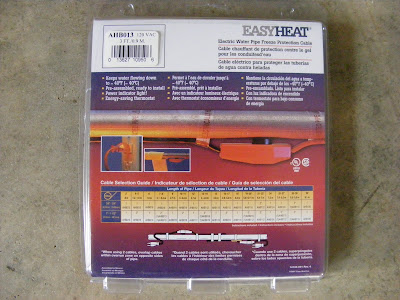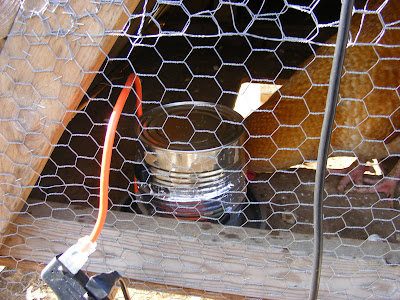HOW TO: Make a chicken waterer that doesn't freeze
>> Wednesday, December 16, 2009
The water in our chicken coop keeps freezing! What's a backyard poultry farmer to do? Build a homebrew chicken water warmer. Here's how we did it:
To start, you'll need a large tin coffee can, or something comparable. It just needs to be metal.
Next, buy an "Electric Water Pipe Freeze Protection Cable," also known as a "Pipe Heating Cable." These are supposed to be used for keeping exposed pipes from freezing. Our local Ace Hardware had a nice selection of lengths. For this project, you'll want the one that's just three feet long. Out of the box, they look like this:
The black part is the heating cable.
The larger orange case is the thermostat, and the black circle is the sensor that must be touching whatever you need to keep warm. This Easy Heat model kicks on when the temperature falls to 38 degrees Fahrenheit, and warms the water until it reaches 45 degrees F. The documentation says it works down to -38 degrees. If that claim is ever tested, our chickens are going to have bigger problems than a frozen water dish.
The last thing you'll want is a tape that can withstand temperature extremes. The Easy Heat manual says electrical tape is fine, but we went fancypants and bought metal repair tape usually meant for duct repair. (*See EDIT, below.)
Lastly, you'll need a short cake pan. We chose a heart-shaped pan because we love our chickens. Also, it was getting rusty and we were going to throw it out anyway.
Wrap the heating element part of the cable around the can in a downward spiral, beginning about an inch from the top. Be sure that when you finish, the thermostat part of the cable isn't so low that it'll be sitting in your water. To make sure we didn't screw up, we put the can in the cake pan to help us eyeball it. Make sure the black circle that senses the temperature of the can sits as flat as possible against the can.
Tape down the end of the heating cable at the top, and then tape the wire in front of and behind the thermostat, to keep the thermostat from losing its contact.
Once we had all the ends taped down,we went back and added metal tape all along the cable. We figured this would make the connection more secure all along the heating element, and perhaps keep a bit of that heat focused inward, rather tan outward.
Using a hammer and a Philips-head screwdriver, punch a hole in the can near the height of the cake pan rim, but still below it. The hole is essentially your water line, as, through the miracle of science, the water inside the can will only pour out until the water level outside covers the hole. The same principle works in the dog and cat watering stations that use an upturned two-liter soda bottle.
For the hole punching, remember to put something on the inside to hammer against, or you'll just dent your can. The corner of a table you don't mind getting scratched works well.
To keep the electrical cord up out of the water (more for chicken accessibility than any worry about the wire in the water) we also ran the orange electrical cord straight back up the can and put a piece of tape on it to hold it there, but you can handle the cord in whatever way works best for your coop.
And that's it! It's time to fill up your new de-luxe, heated chicken waterer and plug it in. To fill it, remove the can from the cake pan and fill it up in the sink. Put the cake pan over the open mouth of the can (upside-down) and flip the whole thing over. Do this quickly, and right where you're going to be setting it down, just in case it sloshes. To our surprise though, this actually wasn't a messy affair.
We already had electricity running to our coop to power an incandescent bulb on a Christmas tree timer, both to keep our chickens warmer and to extend the chickens' daylight hours, which keeps our hens laying all winter long. (The tree timer is the green box hanging there in the picture; it clicks on at dusk, and can be programmed to switch off again a set number of hours later. We found ours at Target.) The only way to test this sucker was to plug it in out there in the cold and see if it kept the water from freezing, and darn if it didn't work! While our other waterers are frozen solid, the water in our No-Freeze Chicken Waterer is fresh and frost-free all day and all night long. (*See EDIT, below.)
Here's hoping your chickens stay warm and well-watered this winter!
*EDIT: First, don't use the silver reflective tape. The chickens will just eat it. (Our did, at least.) Instead, we've attached the heating cord with the duct joiners that tighten when you use a screwdriver on them. (Pics to come.) Second, the waterer still freezes at very low temperatures. I don't know an exact level, but if the temperature is even in the 20s, you'll still have an ice block. It still works right around freezing, but for anything much colder...ah, well. Back to the drawing board.





















8 comments:
Awesome! I loved your design for the Chateau, and I'll have to bookmark this post as well. I've finally talked my husband into it...we're getting chickens in the spring!
We've only had two problems with this so far: 1) if the power goes out, it's kind of pointless, but then again when the power goes out we have bigger issues at hand. 2) when we leave this alone with the chickens for more than a day or two (like, while we're traveling) they peck off all the silver tape. It's weird. We don't know why. There was still water in the thing, so they weren't pecking an empty can trying to get water from it. Worse, the silver tape is nowhere to be found, so we're afraid they ate it. We're going to try rebuilding the thing with a different kind of tape, something not so shiny, and see if that helps. Otherwise, the thing really does work as advertised...
Cheap and easy fix is to attach a reptile warming pad to the underside of the galvanized steel watering can. I have the watering can up on a cinderblock so there is no pressure on the pad itself. The cord runs through the hole in the cinderblock.
We use a heated chicken water tank. It has an element at the bottom and costs about $35 at TSC. I like your design and it is a great, low cost alternative for areas not in the Great White North.
i believe it may work better if you started the pipe heater cable from the bottom of the can, so the switch everything around, because heat rises. so the water will stay warmer towards the bottom and that heat should transfer upwards. but chickens like silver things, so they probably would end up pecking the can as well. a longer pipe heater cable might make it work better. duct tape would probably work to tape it to the can. great idea, i'm actually going to try it out.
Sounds like a good plan. To be honest, we've since replaced this design with something less homebrew, but more effective: a friend had a large electric dog water bowl he didn't need anymore, and we've used it ever since. It too has the heating element on the bottom, as you suggest. We didn't buy it, so I don't know where you get one, but I'm assuming they have such things in pet supply stores. It does get mucky since it has no cover, but we just put it in a place where we can tip it frequently and wash it out.
OMG... I came across this page when I was looking for answer on my home-made waterer. Crazy, it looks exactly like this one. The heater cord was given to me, so I didn't know exactly how it worked until I saw this post. My issue is RUST.... my can is rusting .. hopefully the sensor not touching the can will fix the trick. I also have a plastic lid on the can. Could that be causing the rust? Also, i have the entire cord taped with strong duct tape.
To tell you the truth, we eventually ditched this method entirely and just went with a heated plastic dog bowl. You can buy these at pet supply stores, and they work great. It's a big plastic bowl with a cord coming out of the bottom. We just poured water from a plastic jug into it every day. Some days were so cold we had to break the ice on the surface, but since we live in the south it never got TOO cold to use it. We just kept the thing plugged in all winter. Worked great--and was a lot less hassle than this mess. Hope you find a solution that works for you!
Post a Comment